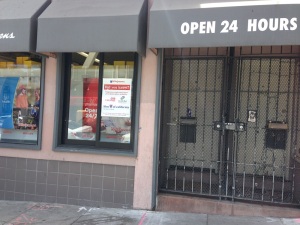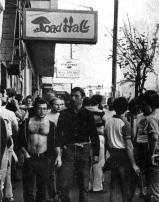 Currently: Walgreen’s mezzanine
Currently: Walgreen’s mezzanine
Previously: The Phoenix; DJ’s; Toad Hall
482 Castro Street
San Francisco, California 94114
Status: No longer a bar
History
Summary
| Name | Dates of Operation |
| The Phoenix | 1982 – 1997 |
| DJ’s | 1980– 1981 |
| Toad Hall | 1971 – 1979 |
Details

Toad Hall opened on May 28, 1971, Memorial Day weekend, by four gay men and a woman – Ron Estes and David Monroe of the Lion’s Pub, a gay “sweater” bar at Sacramento and Divisadero that opened in 1969, with Tom Sanford and Sam Hall, along with the financial support of Marjorie Deremer, a well-off senior citizen who passed away in 2000. It was one of four gay bars that year to join the three other gay bars that already existed in the Castro. (The Lion’s Pub still exists, but gradually stopped being a gay bar sometime in the early 2000s.)
Tom Sanford had a metal statue of a nun and had hoped to call the bar The Iron Nun, but one of the landlords, a pharmacist at Star Pharmacy next door (where the first notices of a “gay cancer” hitting the Castro would be posted in 1981) named Eugene Longinotti, who was a devout member of Most Holy Redeemer Parish, was willing to accept a gay bar for a tenant but not one whose name sounded so blasphemous.
The bar was instead named Toad Hall after the home of one of the characters from Kenneth Grahame’s 1908 children’s book The Wind in the Willows, an awkward character who never felt at ease with the other characters – a nod to the homosexual undertones some believe the book to have, and, because of the toadstool on the bar’s shingle, perhaps also to psilocybin mushrooms. Jason Phillips, a local artist, painted a mural depicting Toad’s adventures that was hung on the wall behind the bar.
It was the first gay bar in the neighborhood to allow dancing – at least for a time until the police noticed they didn’t have a dance permit. At a time when bar music was limited to juke boxes, the owners decided to control the music by creating mixed tapes with a carefully-planned set list of songs. When other bars started to do the same, Toad Hall became the first in the Castro to install a music system and hire a DJ.
In 1973, the bar was hit by three of the four fires that would burn the place. Susan Stryker’s Gay by the Bay suggests that Toad Hall was one of several gay businesses affected by arson (“Gay businesses were frequent targets of bombings and arson. One gay bar, Toad Hall, was burned out three times in three months during 1973,” p. 77), but Toad Hall’s manager, Stan Walker, denied that any of the fires were anything but accidental.
The first came from a mountain of wax that had been built up from the drippings of votive candles. A candle was accidentally left burning overnight, causing the wooden shingles on the walls to catch on fire. The damage looked worse than it was, and the bar was able to remain open during renovations. David Swain, a local carpenter, was hired to repair the damage and ultimately redo the entire bar, which he did four times during Toad Hall’s short history. He later created the Midnight Sun’s aluminum foil motif when it was at its original Castro Street location.
The remodel took about a year. Not long after he was done, just two weeks before Gay Pride of 1974, the bar was completely gutted by another fire. Employees and onlookers alike were recruited to help excavate the wreckage and dump it into a constant stream of Sunset Scavenger dumpsters. The Castro Café next door provided sandwiches for the workers as well as electricity through an extension cord. It took their insurance company two years to pay for the repairs; Marjorie Deremer in the meantime paid for the renovations out of her own pocket.
Just days before the bar was about to reopen, a third, much more minor fire occurred, caused by incomplete electrical wiring work. Fire fighters were able to put out the fire in minutes, but in the meantime, the commotion resulted in an impromptu block party on Castro Street outside the bar.
Toad Hall closed in 1979 and from 1980-81 was a new bar, DJ’s. Then in 1982, a new dance bar arose from the ashes of Toad Hall’s many fires: the Phoenix. For many years, the Phoenix was one of the few places in the Castro where people could dance until the Café San Marcos remodeled in the early 90s, putting in a dance floor and shortening its name to The Café.
The Phoenix closed in 1997 and the space was absorbed into Walgreen’s Pharmacy, which had taken over the old Star Pharmacy in 1985. Due to Castro Street’s slope, the area that was the street-level bar area is now accessed up a few stairs in the back mezzanine area of the pharmacy.
In January of 2008, Gus Van Sant came to the Castro to begin filming his feature film Milk, a biographic film about Harvey Milk starring Sean Penn as the assassinated gay rights leader and James Franco as his lover, Scott Smith. Much of the Castro was renovated to appear as it had in the ’70s. One scene takes place at Toad Hall. Because Walgreen’s couldn’t be made to look like the old bar, the façade of 440 Castro was instead redone to appear like Toad Hall. The film was released in November of 2008, ultimately earning a Best Actor Oscar for Penn and a Best Original Screenplay Oscar for Dustin Lance Black.
Perhaps trying to capitalize on the publicity the film might bring, Les Natali renamed the still-closed 18th Street Bar – formerly the Pendulum – to be Toad Hall in July of 2008, four months before the film was released. Natali claims, though, that the change was in the works long before he knew about the movie and was instead based on his own fond memories of the original bar which he used to frequent but had no business connection with other than as a customer. The current Toad Hall, which ended up opening long after the film was released, has no formal connection to the bar that used to be at 482 Castro Street.
Sources
Bajko, Matthew S., “Film crew descends on Castro,” Bay Area Reporter, January 24, 2008.
de Jim, Strange, San Francisco’s Castro, Arcadia Publishing, 2003.
Leyland, Winston, Out in the Castro: Desire, Promise, Activism, Leyland Publications, 2002, 0-943595-88-6.
“Milking the Castro’s Queer History,” The Advocate, November 12, 2008.
“The rebirth of Toad Hall,” Big Gay Frat House Blog, February 26, 2009.
Stryker, Susan and Jim Van Buskirk, Gay by the Bay, Chronicle Books, 1977, 978-0811811873.
“A Tribute to Toad Hall,” Uncle Donald’s Castro Street.
Whiting, Sam, “Where History Was Made: A tour of 41 points of gay interest all across the city,” San Francisco Chronicle, June 23, 2000.
Location
482 Castro Street, San Francisco
I had the pleasure of working there starting on Super bowl sunday in 1985. But the Phoenix was hit hard by AIDS. Between 1984 and 1987 the majority of the workers there succomed to the illness. Coming out, combined with death and remorse, to the backdrop of the Reagan presidency are the memories of my 20’s at the Phoenix.
Carl, my then boyfriend and I lived right above the Phoenix in the 80’s…. Did they have a motorcycle hanging above the bar ????